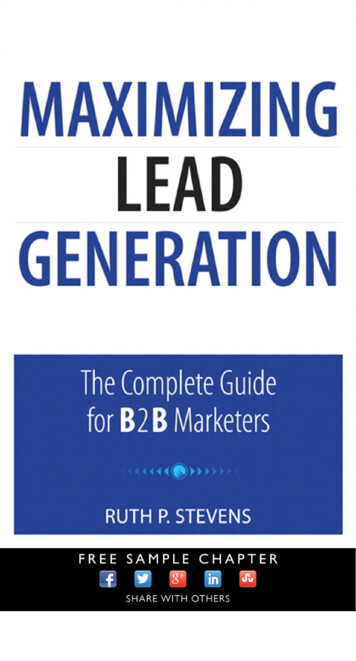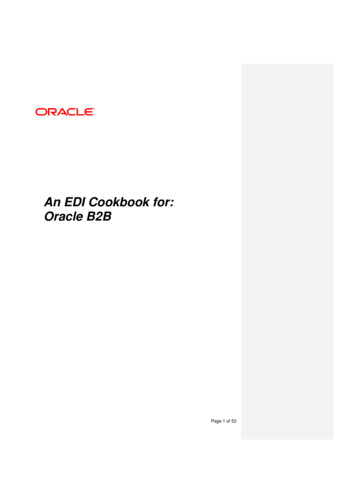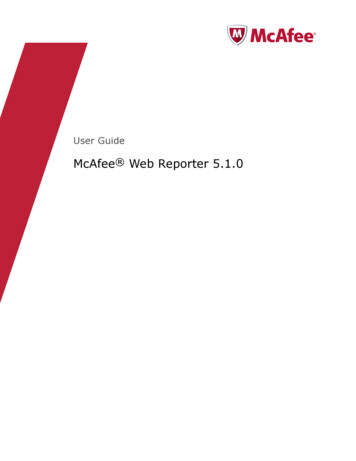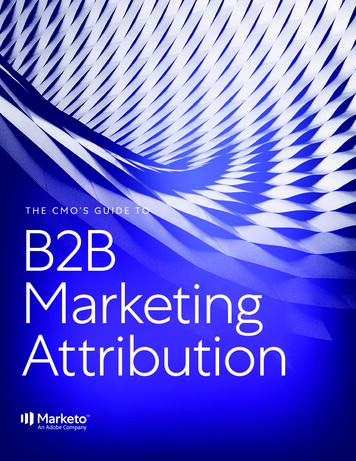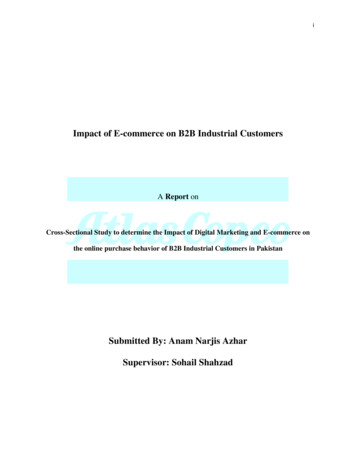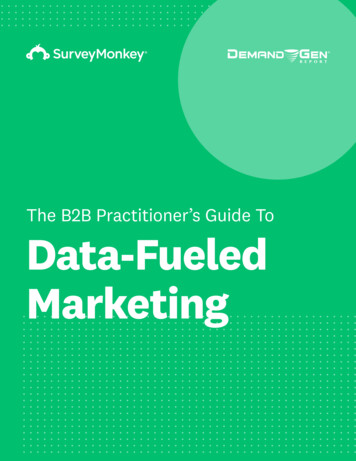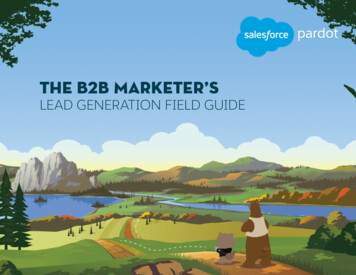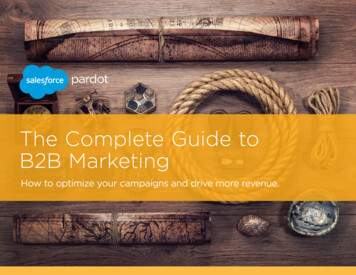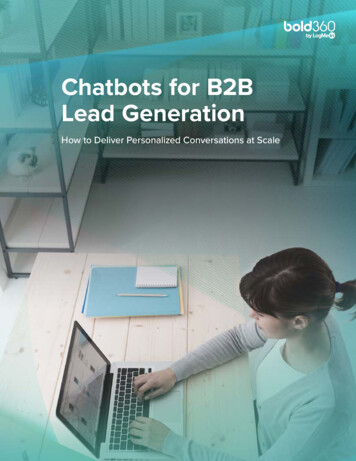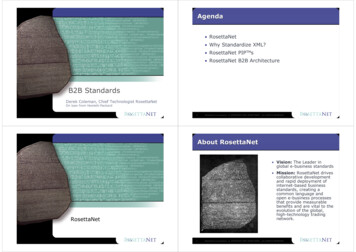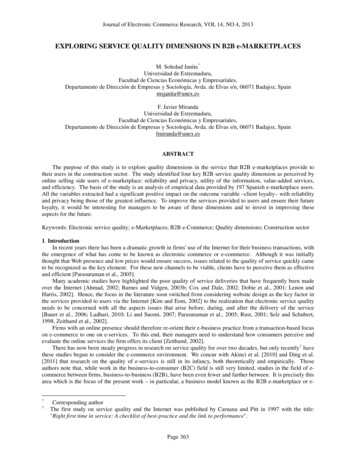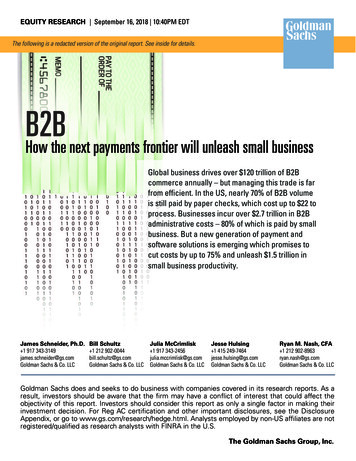
Transcription
EQUITY RESEARCH September 16, 2018 10:40PM EDTThe following is a redacted version of the original report. See inside for details.B2BHow the next payments frontier will unleash small businessGlobal business drives over 120 trillion of B2Bcommerce annually – but managing this trade is farfrom efficient. In the US, nearly 70% of B2B volumeis still paid by paper checks, which cost up to 22 toprocess. Businesses incur over 2.7 trillion in B2Badministrative costs – 80% of which is paid by smallbusiness. But a new generation of payment andsoftware solutions is emerging which promises tocut costs by up to 75% and unleash 1.5 trillion insmall business productivity.James Schneider, Ph.D. 1 917 343-3149james.schneider@gs.comGoldman Sachs & Co. LLCBill Schultz 1 212 902-0044bill.schultz@gs.comGoldman Sachs & Co. LLCJulia McCrimlisk 1 917 343-2456julia.mccrimlisk@gs.comGoldman Sachs & Co. LLCJesse Hulsing 1 415 249-7464jesse.hulsing@gs.comGoldman Sachs & Co. LLCRyan M. Nash, CFA 1 212 902-8963ryan.nash@gs.comGoldman Sachs & Co. LLCGoldman Sachs does and seeks to do business with companies covered in its research reports. As aresult, investors should be aware that the firm may have a conflict of interest that could affect theobjectivity of this report. Investors should consider this report as only a single factor in making theirinvestment decision. For Reg AC certification and other important disclosures, see the DisclosureAppendix, or go to www.gs.com/research/hedge.html. Analysts employed by non-US affiliates are notregistered/qualified as research analysts with FINRA in the U.S.The Goldman Sachs Group, Inc.
Goldman SachsGlobal TechnologyTable of ContentsExecutive summary3Setting the stage: The B2B market landscape6Today’s B2B market: Significant direct and indirect cost burdens, borne by small business8How can payment and software solutions help?15Who can make money and how much?25Challenges in the adoption of B2B payment solutions28Disclosure Appendix30Note: The following is a redacted version of “Global Technology: B2B: How the next paymentsfrontier will unleash small business" originally published September 16, 2018 [48pgs]. All companyreferences in this note are for illustrative purposes only and should not be interpreted as investmentrecommendations.2
Goldman SachsGlobal TechnologyExecutive summaryB2B Payments: The biggest untapped market opportunity for the payments industryWe believe B2B payments currently account for 127tn in payment flows - and weexpect this figure to reach nearly 200tn by 2028, over 5X the volume of the retailpayments market. With the vast majority of invoices still processed manually and paidby paper check, we see significant opportunities for business to reduce costs - creatingnew revenue pools for payment and software companies entering the market withfaster, lower-cost invoice processing and payment solutions. While large businesses andenterprises account for over half of B2B payment flows, we see the biggest revenueand cost savings opportunities for small business, where 80% of invoices are stillmanually processed and paid by check.B2B solutions can unleash nearly 1.5 trillion in productivity for global small businessToday, the majority of global businesses still depend on manual, paper-based paymentprocesses that command a steep price tag in terms of time, money, and operatingfriction. We estimate businesses in North America spend 187bn annually on accountspayable (“AP”) processing - and this estimate captures only direct processing and laborcosts. We believe these same businesses are spending closer to 510bn after takingindirect costs - such as short-term credit and additional fees for cross-bordertransactions - into account. North America represents only a fraction of the B2B market and we believe the total global costs related to AP amount to over 2.7tn.While thus far the digitization of B2B payment flows has been slow - especially amongsmall business - we believe the market is finally poised to accelerate. We see severaltechnological and market changes driving this acceleration, including the adoption bysmall business of software-based general ledger and accounting systems, the broaderemergence of real-time payment infrastructure, and the introduction of novel businessand financing services.The opportunity: A fresh 1 trillion revenue opportunity in payments & softwareWe see a significant revenue opportunity for payments companies, softwarecompanies, and banks to capture meaningful market share over time, whilesimultaneously driving substantial cost savings for business. In total, we see a 950bnglobal revenue opportunity (with an estimated 186bn in North America) across invoiceprocessing, AP payment processing, working capital management and factoring, andcross-border payment optimization. Our analysis assumes that B2B payment solutionscan drive up to 75% savings in total costs (both direct and indirect) for business, withmore savings accruing to small businesses than enterprises.3
Goldman SachsGlobal TechnologyExhibit 1: B2B market landscape with key public and private playersSource: Goldman Sachs Global Investment Research4
B2B Payments VolumesTodayBy 2028 200 trillion 127 trillionWe estimate global B2B volumes will reach over 5 times thebusiness-to-consumer market over the next decade.Accounts Payable (AP) Costs Today 2.7 trillionSmall Business Bearsthe Brunt 80%SMBs account for this much of the totalannual spending on labor and accountspayable processing.But AP Automation CanCut Costs Up to 75%The potential net savings forbusinesses who adopt AP automationsolutions.What businesses are spending onmanual, paper-based paymentprocessing, which is a big burden interms of time and money.Paper Checks Still Dominate60%Vs.80%Our estimate for thetotal number of B2Bpayments still madeby check.Our estimate for thenumber ofsmall/medium-sizebusiness paymentsmade by check.The Revenue Opportunity 950bnAcross the B2B payments universe, we see thelargest revenue opportunities in AP invoiceprocessing, AP payment processing, workingcapital management and factoring, and crossborder payment optimization.
Goldman SachsGlobal TechnologySetting the stage: The B2B market landscapeWe estimate that B2B payments currently account for nearly 127tn in paymentflows - and expect this figure to reach nearly 200tn by 2028, over 5X the volumeof the retail payments market. With the majority of invoices still processedmanually and paid by paper check, we see significant cost savings opportunitiesfor businesses plus significant new revenue pools for payments and softwarecompanies entering the market with faster, lower-cost invoice processing andpayment solutions. Although large businesses and enterprises account for overhalf of B2B payment flows, we see the biggest cost savings and industry revenueopportunities for small businesses, where 80% of invoices are still manuallyprocessed and paid by check.We estimate that B2B payment volumes will reach 200tn by 2028 - five times thesize of the B2C market. We believe global B2B payments account for 127tn inpayment volume today and will reach 200tn in ten years. We believe North Americacurrently accounts for 20% of the B2B market or 26tn in payment volume.Exhibit 2: We estimate B2B volumes will reach 200tn in the next decade, 5X the size of B2C volumesGlobal payment volume estimates, 2018 vs. 2028Source: Goldman Sachs Global Investment ResearchLarge businesses generate just over half of payment volumes.In the United States, B2B payment flows are dominated by enterprises and largebusinesses (over 500mn in revenue), even though less than 10% of firms fall into thiscategory. We estimate that small businesses (under 25mn revenue) account for only aquarter of B2B payment volumes even though over half of all US businesses fall into thiscategory. We use US firm demographics as a proxy for North America (United States,Canada, and Mexico). Similar to the US and North America, we believe large businessesgenerate the majority of global B2B volumes - although we believe the internationalbusiness mix is more heavily skewed towards small businesses.6
Goldman SachsGlobal TechnologyExhibit 3: SMBs represent over 50% of firms, but large businesses generate over 50% of payment volumeDistribution of US firms by size; distribution of US payment volume by firm size9%Large54% Large21% Medium36% MediumSmall25%55% Small% Firms% Payment VolumeWe define business by revenue size as follows: Small business under 25mn, medium business 25- 499mn, large business 500mn .Source: Visa, US Census Bureau, Goldman Sachs Global Investment Research.and paper checks dominate the market today.Overall, we estimate that nearly 60% of B2B payments in North America are still madewith paper checks. While this varies by company size – we estimate checks account forup to 80% of small/medium-size business payments vs. roughly half of large businesspayments – paper checks remain the dominant form of payment across markets despitegenerating process inefficiencies and high overhead costs. Digital payment forms including ACH and card - account for only 36% of B2B payments today.Exhibit 4: We estimate checks still account for approximately 60% of B2B payments in North AmericaB2B payments mix by firm size, North America rWe define businesses by revenue as follows: Small businesses under 25mn, medium businesses 25- 499mn, large businesses 500mn .Source: Goldman Sachs Global Investment Research7
Goldman SachsGlobal TechnologyToday’s B2B market: Significant direct and indirect cost burdens, borne bysmall businessToday, the majority of businesses still depend on manual, paper-based paymentprocessing, which represents a significant cost burden in terms of both time andmoney. We estimate businesses in North America are spending 187bn annuallyon accounts payable (“AP”) processing - and this estimate only captures directprocessing and labor costs. In reality, we believe businesses are shouldering up to 510bn in B2B payments costs when including indirect costs such as short-termcredit for receivables financing and cross-border transaction fees. We believe thetotal direct and indirect B2B payments cost borne by global business is nearly 2.7tn.Exhibit 5: We estimate businesses spend over 510bn in North America and 2.7tn globally on APEstimates for direct and indirect manual AP costsCost per invoice using a manual AP management processNorth AmericaWorldSmallMediumLargeTotalTotalPayment volume ( bn) 6,500 5,460 14,040 26,000 127,320Average invoice ( )TotalTotal 1,000 3,000 10,000Invoices (mn)6,5001,8201,404Direct costsSmallMediumLarge 1.47 1.31 1.16 10 2 2 14 660.1%0.0%0.0%0.1%0.1%Processing costAverage processing cost per invoiceTotal processing cost ( bn)Headcount CostsInvoices processed per month1,0003,00010,000Average headcount cost per invoice 20.79 14.69 8.23Total headcount cost ( bn) 135 27 12 173 8492.1%0.5%0.1%0.7%0.7%Direct cost per invoice 22.26 16.00 9.39Total direct cost ( bn) 145 29 13 187 9162.2%0.5%0.1%0.7%0.7%SmallMediumLargeTotalTotal 3,941 23,099Total cost (%)Indirect costsCross-border costCross-border volumeCost (% volume)4.4%4.4%Total cross-border cost ( bn) 174 1,020Cash management costInventory financing cost ( bn) 125 610Late fees ( bn) 25 122Total cash management cost ( bn) 150 732Total indirect cost ( bn) 324 1,752Total direct indirect costs ( bn) 511 2,668Source: Goldman Sachs Global Investment Research8
Goldman SachsGlobal TechnologyManual processing: The direct costsTraditional payables processes are labor-intensive and inefficient, with manualintervention needed to receive and approve the invoice as well as to make the paymentand reconcile accounts. In the exhibit below, we outline a typical manual accountspayable process. Opportunities to automate these processes can yield significant costsavings.Exhibit 6: Labor accounts for over half the costs in a traditional, manual AP processManual accounts payable processPurchase orderReceive invoice and storedataMatch invoice withpurchase orderBuyerInvoiceInvoice ProcessingResend InvoiceSupplierIf inaccurateReceive check andensure accuracyArchive the invoiceIf accuratePaymentGet manager approvalEnter data into accountingsystemDeposit check (receivepayment in 2-3 days) Print and writecheck Mail check Source: Goldman Sachs Global Investment ResearchLabor is the most significant single driver of these costs - we estimate it accounts forover 90% of direct costs incurred. According to a survey by Hyland Software, APemployees spend an average of 30% of their time collecting data (e.g., purchase ordersand invoices) and answering questions from employees, collectors, or vendors relatedto the AP process . Employees also spend a significant amount of time resolving issuesthat arise from input errors and tracking down managers for approval. These pain pointssignificantly increase the cost of AP processing.Exhibit 7: We estimate automated costs are only 33% of manualcosts, mainly due to the elimination of significant labor costsExhibit 8: Accounts payable personnel spend 30% of their time onroutine tasksComparison of manual costs (processing labor) to automated costsAP team workpercentage of time 0%15%7%10%6%5%0%Answering APrelated queriesSource: Goldman Sachs Global Investment ResearchSearching for Enforcing Rulesdocumentation& PoliciesSource: Hyland Software9
Goldman SachsGlobal TechnologyKey pain points in manual AP processing include:nInvoice intake: Invoices are not standardized across suppliers and instead arereceived in a huge variety of paper and electronic formats with non-standardizeddata fields. According to AvidXchange, 56% of invoices are received in a manualformat (paper, PDF, email, or fax).nData capture: Given the abundance of non-standar
04.09.2019 · Goldman Sachs does and seeks to do business with companies covered in its research reports. As a result, investors should be aware that the firm may have a conflict of interest that could affect the objectivity of this report. Investors should consider this report as only a single factor in making their investment decision. For Reg AC certification and other important disclosures, see the .
